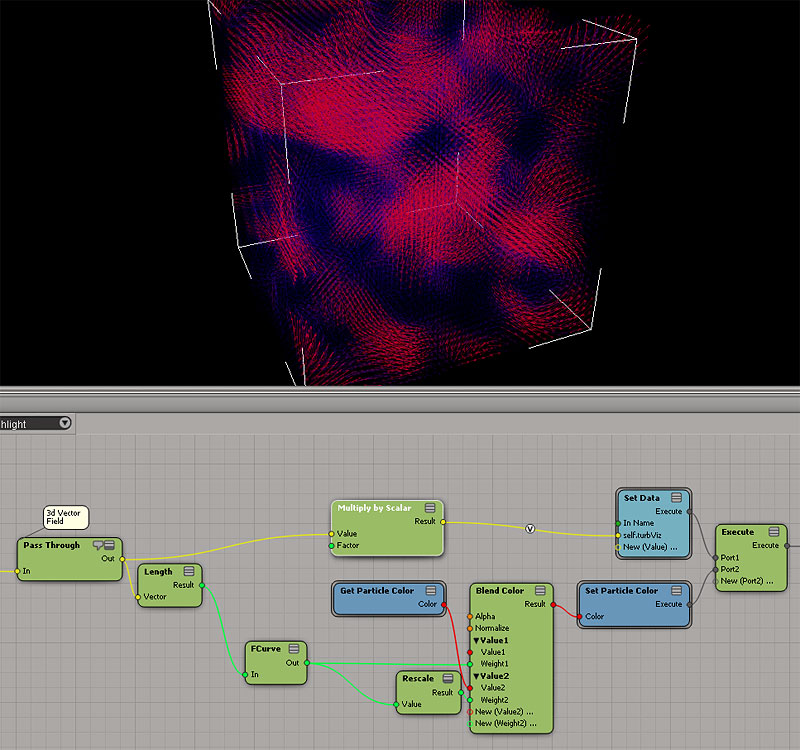A patch of grass - and Turbulize Strands visualization?
Morten Bartholdy
I thought I would share the current result of my endeavour into ICE. I need to work more on variations and especially understand Turbulize Strands better, but the method is solid and quite workable. Here it is:
http://dl.dropbox.com/u/763668/ICE/Grass_field_HR_02.mov - 37 MB 1080p rendered with Arnold.
Is there a way to spatially vizualize what the Turbulize Strands does? I am thinking a bit like the debugging mode showing velocities in emFluid.
Best Regards
Morten Bartholdy
VFX Supervisor/3D Lead
www.gimmickvfx.com
Jeff McFall
very nice!
Andy Moorer

Morten Bartholdy
Yes, filling the front is an issue. I use a weightmap filter to get denser growth close to the camera, but it oviously only works for when the camera is not moving about much. Thankfully ICE allows me to have many strands :)
That vector field visualizer is exactly was I was looking for Andy - cool! So you are piping the twin turbulize in to the Pass Through node at the left hand side of the ICE tree, no?!
- Morten
Stefano Jannuzzo
Andy Moorer
Marc-Andre Carbonneau
Another alternative is iGrass
http://rendering.ru/ru_en/models/igrass-vol1.html
you just need to bring them in Soft but they look pretty slick.
Fabricio Chamon
Andy Moorer
Sent from my iPad
On Mar 21, 2012, at 1:30 PM, Fabricio Chamon <xsim...@gmail.com> wrote:
> ...forgot the compound
> <vectorfield_viewport.jpg>
> <vectorfield_icetree.jpg>
> <Display Vector Field.xsicompound>
piotrek marczak
Steven Caron
Morten Bartholdy
Final strand count is not that high - only 1.159.577 strands. I would have to crank it up anyway if I didn't use textured ground to fill in. In total the instanced grass straws polygon count would be around 164 million total. This is WIP, so I suspect when I have more finalized scenes there will be a lot more in there.
Render time is around 18 mins/fr on dual Xeon x5660 2.80GHz at samples 8-1-1-1 a bit of DOF and a Skydome light.
- Morten
Nice! Number of strands? Render time?
Morten Bartholdy
Big thanks, Andy and Fabricio. This is exactly the kind of visualization I was looking for, and you are right it ought to be built in from factory as a debug node. Nice Turbulence node BTW Andy! I owe you guys!
Andy, I tried installing your visualization compound, but when I pick it from the tool tabs (I added the category and exported the compound) it doesn't display anything after piping the box null and the turbulence in. Your scene works fine though :)
I can see how stretching the turbulence in one axis can make it look better - now with a visualization of the field it will be much easier to get it right. This far I have been doing captures of a low number of strands to figure out the scaling and speed.
- Morten
Morten Bartholdy
Sorry Marc-Andre, it was not supposed to go directly to you.
I didn't read it as critique either ;) but the goal is to make photoreal grassy fields as digital sets for live action shot on green screen in a studio, so I will have to get real :)
There is nothing fancy about the compounds - let me clean it up some, then I will share. Give, and ye shall receive :)
- Morten
Den 22. marts 2012 kl. 14:09 skrev Marc-Andre Carbonneau <marc-andre...@ubisoft.com>:
Hehe I was not criticizing what you posted. It already looks nice. I just wanted to share these iGrass things because I’ve converted them all for ourselves and although I don’t have dynamics, it looks nice when used with Milan’s Scatter Tools!
Have you shared the compounds you used to create such windy field?
Take care,
MAC
From: Morten Bartholdy [mailto:x...@colorshopvfx.dk]
Sent: 22 mars 2012 08:54
To: Marc-Andre Carbonneau
Subject: RE: A patch of grass - and Turbulize Strands visualization?
Thanks for the link. Yeah they look good - it is next order of things for me to model more varied grass and small plants, so maybe I can save some time here. Bugger it is Max though - I will have to ask someone else here to export them if they don't supply obj or fbx.
- Morten
Den 21. marts 2012 kl. 17:49 skrev Marc-Andre Carbonneau <marc-andre...@ubisoft.com>:
--> -->
Another alternative is iGrass
http://rendering.ru/ru_en/models/igrass-vol1.html
you just need to bring them in Soft but they look pretty slick.
From: softimag...@listproc.autodesk.com [mailto:softimag...@listproc.autodesk.com] On Behalf Of Andy Moorer
Sent: 21 mars 2012 12:29
To: Morten Bartholdy; soft...@listproc.autodesk.com
Subject: Re: A patch of grass - and Turbulize Strands visualization?
Glad it's of use. Yep, whatever vector field you want to visualize is your input.
If you hook it up to a compound which emits a grid of points based on position of a null, you can just leave it in your scene and turn it on whenever you need to view a field, with the null allowing you to position a "bounding-box" to visualize the area of interest.
I suppose you could write whatever the vector field is to a user attribute and read it directly instead of copying a node, I just hate making any changes to my "original" tree on principle.
- AM
Morten Bartholdy
I've hit a snag here with the vector field visualization . I am using Turbulize Strands which has an exec*te output. If I pick the Turbulence inside the compound the visualization seems to be missing some positional or spatial information - can't quite figure it out.
How would you use Turbulize Around Value to deform strands?
- Morten
Andy Moorer
- Modified the "turbulize strands" node to make it non-simulated
- Made the turbulize strands node apply the turbulence in relation to global XYZ instead of local to each strand
- Chopped up the resulting nonsimulated turbulize strand node to have identical inputs excepting strand-specific parameters, and placed it in per-point context.
